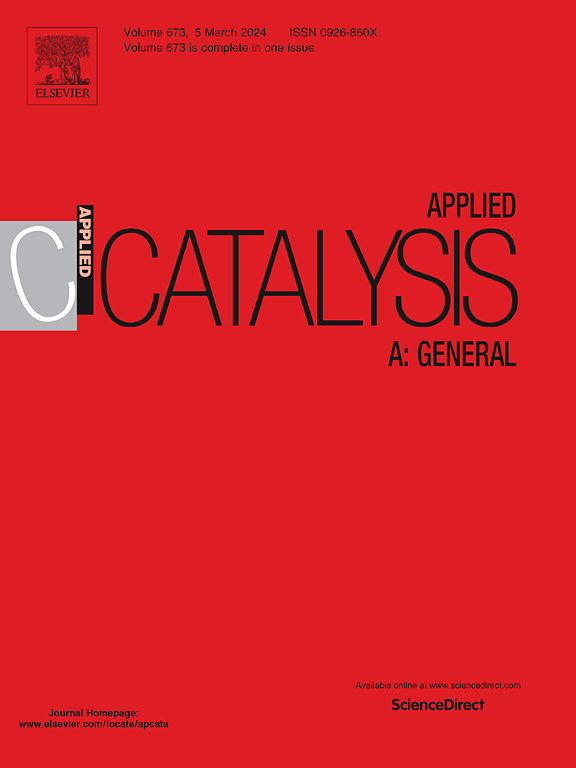甲烷干重整碳抑制用镧锌钙钛矿催化剂氧迁移率研究
IF 4.8
2区 化学
Q2 CHEMISTRY, PHYSICAL
引用次数: 0
摘要
甲烷生成碳是甲烷重整反应(主要是甲烷干重整)的主要问题之一,限制了甲烷的工业竞争力。因此,在这项工作中,我们研究了LaNi-Zn钙钛矿在DRM反应中的氧迁移率和抗碳性。合成了LaNiO3 (LN)和LaNi0.5Zn0.5O3-δ (LNZn)催化剂,并通过XRD、H2-TPR、CH4-TPSR-MS、h2 - tppr - ms、XPS、TGA、Raman、HRTEM和准原位漂移- ms等手段对其进行了表征,以了解促进剂在抑制焦炭中的作用。CH4-TPSR-MS、h2 - tppr - ms和Raman分析表明,zn取代的催化剂比LN催化剂具有更高的氧迁移率,这是由于Zn2+的亲氧性,有利于碳的气化。还原样品的XPS和HRTEM分析证实,表面存在金属zn,为Ni-Zn合金。30 h的TOS对LN催化剂的催化活性高于LNZn。然而,反应后分析表明,锌的加入使碳阻提高了5倍。Ni- zn合金的形成有效地阻止了Ni颗粒从载体上的去除和碳纳米管对其的包裹。准原位漂移-质谱法发现,LNZn催化剂促进了碳氧化的中间物质(CHxO, HCOO毒血症和HCO3毒血症)的形成,清除了zn取代催化剂的反碳行为。本文章由计算机程序翻译,如有差异,请以英文原文为准。
Investigation of oxygen mobility on LaNi-Zn perovskite catalyst for carbon inhibition in dry reforming of methane
Carbon formation is one of the major problems in methane reforming reactions, mainly in dry reforming of methane (DRM), limiting its industrial competitiveness. Thus, in this work, we investigate the oxygen mobility and carbon resistance of the LaNi-Zn perovskite in the DRM reaction. The catalysts LaNiO3 (LN) and LaNi0.5Zn0.5O3-δ (LNZn) were synthesized and characterized by XRD, H2-TPR, CH4-TPSR-MS, H2-TPHR-MS, XPS, TGA, Raman, HRTEM, and quasi-in-situ DRIFTS-MS, aiming to understand the role of the promoter in coke suppression. The CH4-TPSR-MS, H2-TPHR-MS, and Raman analyses revealed that the Zn-substituted catalyst exhibited higher oxygen mobility compared to the LN catalyst, attributed to the oxophilicity of Zn2+, which facilitates carbon gasification. XPS and HRTEM analyses of reduced samples confirmed the presence of metallic Zn0 on the surface as Ni-Zn alloying. 30 h of TOS showed higher activity for the LN catalyst than the LNZn. However, post-reaction analysis indicated that the addition of Zn increased carbon resistance by 5 times. The formation of the Ni-Zn alloying effectively prevented the removal of Ni particles from the support and their encapsulation by carbon nanotubes. Quasi-in-situ DRIFTS-MS has revealed that the LNZn catalyst promotes the formation of intermediate species responsible for carbon oxidation (CHxO, HCOO⁻, and HCO3⁻), clearing the anti-carbon behavior of the Zn-substituted catalyst.
求助全文
通过发布文献求助,成功后即可免费获取论文全文。
去求助
来源期刊

Applied Catalysis A: General
化学-环境科学
CiteScore
9.00
自引率
5.50%
发文量
415
审稿时长
24 days
期刊介绍:
Applied Catalysis A: General publishes original papers on all aspects of catalysis of basic and practical interest to chemical scientists in both industrial and academic fields, with an emphasis onnew understanding of catalysts and catalytic reactions, new catalytic materials, new techniques, and new processes, especially those that have potential practical implications.
Papers that report results of a thorough study or optimization of systems or processes that are well understood, widely studied, or minor variations of known ones are discouraged. Authors should include statements in a separate section "Justification for Publication" of how the manuscript fits the scope of the journal in the cover letter to the editors. Submissions without such justification will be rejected without review.
 求助内容:
求助内容: 应助结果提醒方式:
应助结果提醒方式:


